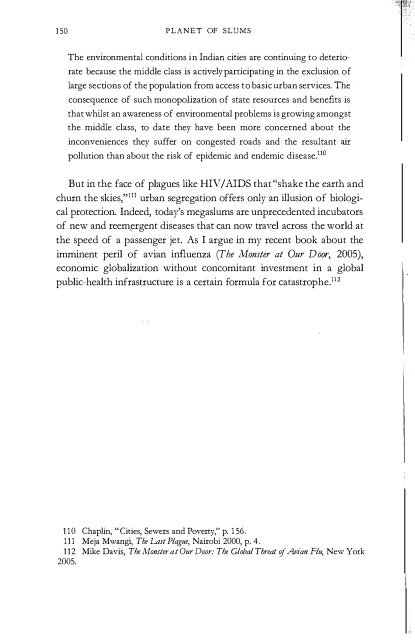Untitled - Rebel Studies Library
Untitled - Rebel Studies Library
Untitled - Rebel Studies Library
You also want an ePaper? Increase the reach of your titles
YUMPU automatically turns print PDFs into web optimized ePapers that Google loves.
150 PLANET OF SLUMS<br />
The environmental conditions in Indian cities are continuing to deterio<br />
rate because the middle class is actively participating in the exclusion of<br />
large sections of the population from access to basic urban services. The<br />
consequence of such monopolization of state resources and benefits is<br />
that whilst an awareness of environmental problems is growing amongst<br />
the middle class, to date they have been more concerned about the<br />
inconveniences they suffer on congested roads and the resultant air<br />
pollution than about the risk of epidemic and endemic disease.11°<br />
But in the face of plagues like HIV / AIDS that "shake the earth and<br />
churn the skies,"111 urban segregation offers only an illusion of biological<br />
protection. Indeed, today's megaslums are unprecedented incubators<br />
of new and reemrgent diseases that can now travel across the world at<br />
the speed of a passenger jet. As I argue in my recent book about the<br />
imminent peril of avian influenza (The Monster at Our Door, 2005),<br />
economic globalization without concomitant investment in a global<br />
public-health infrastructure is a certain formula for catastrophe.112<br />
110 Chaplin, "Cities, Sewers and Poverty," p. 156.<br />
111 Meja Mwangi, The Last Plague, Nairobi 2000, p. 4.<br />
112 Mike Davis, The Monster at Our Door: The Global Threat of Avian Flu, New York<br />
2005.<br />
7<br />
SAPing the Third World<br />
After their mysterious laughter, they quickly changed the topic<br />
to other things. How were people back home surviving SAP?<br />
Fide/is Balogun 1<br />
Slums, however deadly and insecure, have a brilliant future. The countyideill<br />
f;; " ;-sh;t perid - ;;;ilrco;;-th · maJoritY · ;f · the world's<br />
poor, but that dubious distinction will pass to urban slums no later than<br />
2035. At least half of the coming Third World urban population explosion<br />
will be credited to the account of informal communities.2 Two<br />
billion slum-dwellers by 2030 or 2040 is a monstrous, almost incomprehensible<br />
prospect, but urban poverty overlaps and exceeds slum<br />
populations per se. Researchers with the UN Urban Observatory project<br />
warn that by 2020, "urban poverty in the world could reach 45 to 50<br />
percent of the total population living in the cities."3<br />
The evolution of this new urban poverty, as we have seen, has been<br />
a nonlinear historical process. The slow accretion of shantytowns to<br />
the shell of the city has been punctuated by storms of poverty and<br />
sudden explosions of slum-building. In his collection of stories entitled<br />
1 Fidelis Odun Balogun, Adjusted Lives: Stories of Structural A4Justments, Trenton<br />
(N]) 1995, p. 75<br />
2 Martin Ravallion, On the Urbanization of PovertY, World Bank paper, 2001.<br />
3 Eduardo L6pez Moreno, Slums of the World: The Face of Urban PovertY in the New<br />
Millenium?, Nairobi 2003, p. 12.


